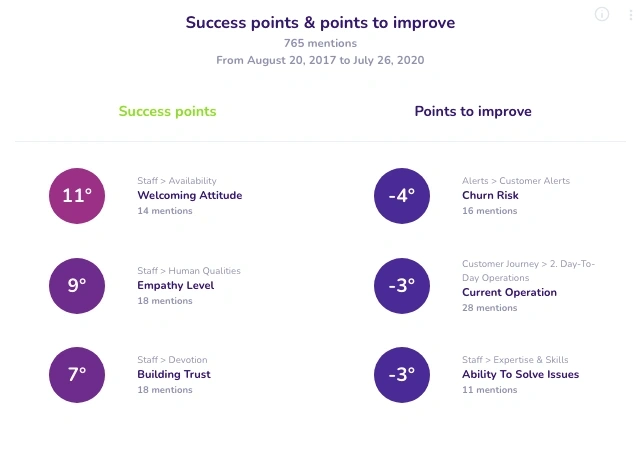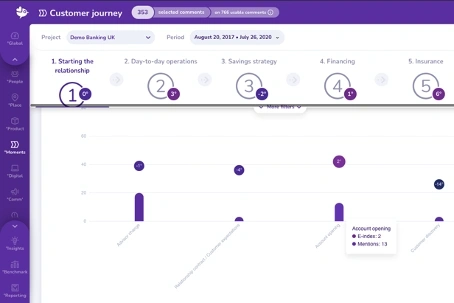How to combine satisfaction surveys and emotional analysis?
Published on March 18, 2021 - Updated on December 04, 2023
How to create a satisfaction survey and analyze the results?
In any business, collecting and analyzing customer feedback is essential. It would be a shame to take just a few opinions (positive or negative) and make them general. The opinions of your customers are often rich and a great source of improvement. This is why collecting and analyzing your customer verbatims will allow you to improve your rating score or your NPS (Net Promoter Score). As customer data collection is a sensitive subject, it is important to be familiar with the subject before getting started!
Collecting customer data should be a routine
Enter a world of data
Because you need to base your conclusions on concrete elements and cannot create yourself independent reviews (!), you will need to find or generate the concrete data from your customer base in relationship with the customer experience.
Because you cannot launch actions based on outdated conclusions, you will need the latest data available or -even better- fresh data, and because your product and service level are daily changing, you will need to do it constantly: This is why you will have to think it as a workflow and to integrate the data collection as a workflow into other sales and operating workflows.
GDPR and Customer’s consent
It is mandatory for all companies in the EU or if they are collecting any kind of personal data of EU nationals. Even if a combination of data collected through surveys can reveal the respondent's identity, it can lead to legal trouble. You will need to inform the respondents about the use of the collected data, concede the right to rectification and the right to erasure (also called the right to be forgotten) to them.
If you are based in the European Union, your whole organization needs to be adapted, with the appointment of a Data Protection Officer, etc…
Beyond EU companies, it is advised to be transparent with respondents about the use of personal data. Do not break the link you built with your customer by selling their data to third parties!
Opening surveys
Now that we have understood the legal requirements for collecting data, it is time to take a look at the survey itself. First of all, we must determine the target of the satisfaction questionnaire. Is this one going to be for all of your customers? To your customers who are at a specific stage in your journey? Only customers, who have left you? It is by setting the target of your survey that you can then define the objective of it, for what purpose is it carried out? This is going to be the basis of the project and what will determine the quality of the results that you will get afterward.
Now that you have your target and your objective, it's time to create the questionnaire!
Nowadays, it is easy to open satisfaction surveys for your customers. There are more than 100 tools that may help you build polls. It is a little more complicated to automate the emails and keep a track of the CRM information etc… The most advanced tools propose hot surveys via several channels: mobile apps, SMS, website and emails, etc.
Naturally in our digital area, never use paper to launch a survey, it will be very hard and costly to exploit the data.
Limit yourself to less than 5 minutes answers: do not add paint to your customer!
Ex: you should reduce your survey to a maximum of 10 scorings and a maximum of 3 open questions and test the average time to fulfill it…
Monitoring the satisfaction of your customer
The satisfaction metrics are now well spread into the organization and let get a global view on the customer satisfaction level. The CSAT (Customer satisfaction) is a measure of how satisfied the final customers are with your product, services, and brand.
The satisfaction gauge
The satisfaction gauge is based on a two-dimension scale, from 0 to 4, from 1 to 7, or 1 to 10.

You can administer the so-called CSAT surveys to gauge your customers’ opinions on a number of topics, including their customer experience, buying process, their perception of your products or services, their training and onboarding sessions, etc.
Satisfaction monitoring has limitations
“Satisfaction” isn’t very engaging, and is, in itself, a lukewarm word. It’s the bare minimum we expect from a service. This means that a high CSAT score doesn’t necessarily mean you are maximizing customer engagement or experience.
Make sure you act on feedback to go beyond satisfaction.
As McMillan says:
“Negative feedback is almost like a support ticket.”
You need to act on it to make sure customers don’t churn. But positive feedback is more than a pat on the back – it’s an opportunity.
Emotional analysis of verbatim
In order to take corrective action, monitoring satisfaction is not enough and you risk missing out on important insights. This is why an emotional analysis tool like Q°emotion can help you. Our semantic and emotional analysis SaaS solution will allow you to identify in a few clicks your points of improvement and success on all the comments of your survey.

This will help you prioritize your irritants based on the number of mentions and the emotional index corresponding to each irritant. The added value of your satisfaction questionnaire will only be greater!
In addition, if your survey concerns your customer journey, for example, you will find all of it on our platform as well as the irritants, success points, and verbatims corresponding to each step of your customer journey.

Identify priority areas for improvement in order to increase your rating score or NPS.
You will understand that creating and carrying out a satisfaction survey takes time and resources, but the benefits you will reap by listening to your customers deserve this attention.
If you want to test our solution for free, you can register by clicking here.
Similar posts
Customer Experience vs. Customer Success: Understanding the differences and maximising customer loyalty through emotional analysis
Published on October 29, 2024 - Updated on November 04, 2024
In an increasingly competitive business environment, companies must now redouble their efforts to capture and retain customers. According to a recent study by Forrester , 73% of companies now...
Reduce holiday stress with Q°emotion: How brands can manage customer emotions over Christmas
Published on October 29, 2024 - Updated on February 14, 2025
Reduce holiday stress with Q°emotion: How brands can manage customer emotions over Christmas Introduction: The Christmas paradox Although Christmas is traditionally a time of joy, sharing and celeb...